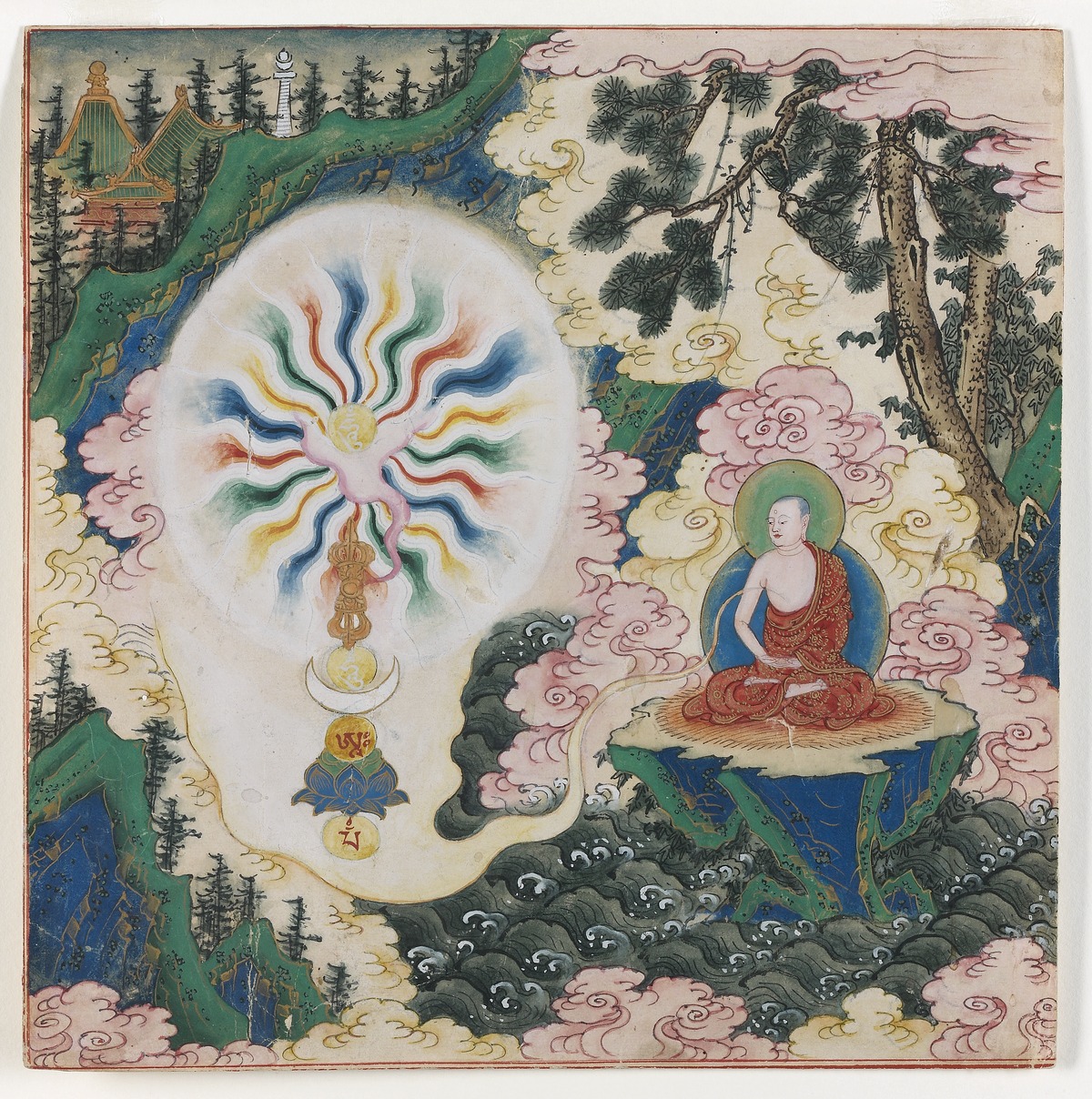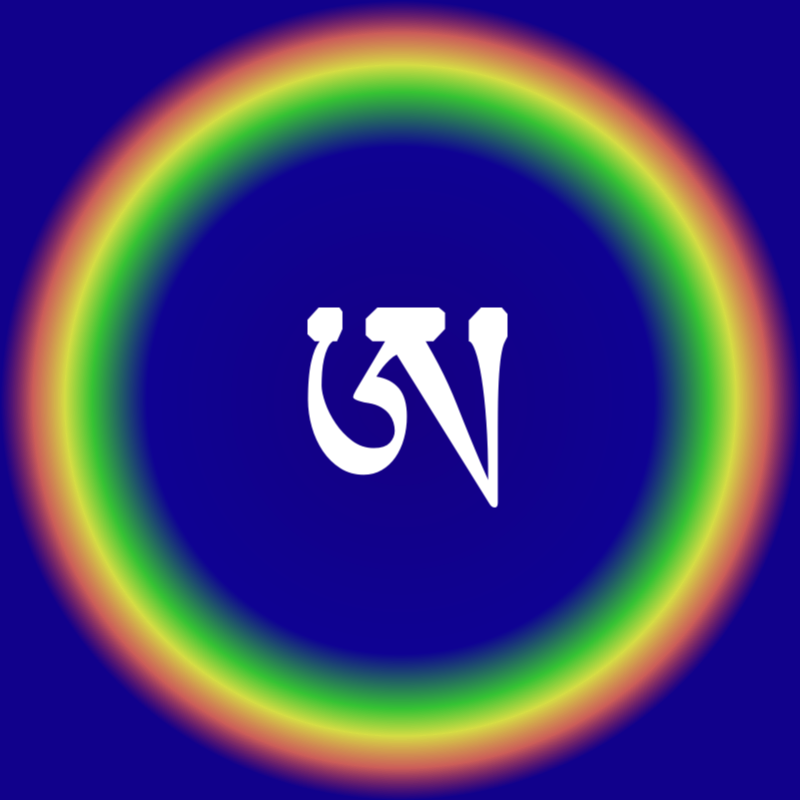|
Atiyoga
Dzogchen (, "Great Perfection" or "Great Completion"), also known as ''atiyoga'' ( utmost yoga), is a tradition of teachings in Indo-Tibetan Buddhism and Yungdrung Bon aimed at discovering and continuing in the ultimate ground of existence. The primordial ground (''gzhi'', "basis") is said to have the qualities of purity (i.e. emptiness), spontaneity (''lhun grub'', associated with luminous clarity) and compassion (''thugs rje''). The goal of Dzogchen is knowledge of this basis, this knowledge is called '' rigpa'' (Skt. ''vidyā''). There are numerous spiritual practices taught in the various Dzogchen systems for awakening rigpa. History Dzogchen developed in the Tibetan Empire period and the Era of Fragmentation (9th-11th centuries) and continues to be practiced today both in Tibet and around the world. It is a central teaching of the Yundrung Bon tradition as well as in the Nyingma school of Tibetan Buddhism. In these traditions, Dzogchen is the highest and mo ... [...More Info...] [...Related Items...] OR: [Wikipedia] [Google] [Baidu] |
Classes Of Tantra In Tibetan Buddhism
Classes of Tantra in Tibetan Buddhism refers to the categorization of Buddhist tantric scriptures in Indo-Tibetan Buddhism. Tibetan Buddhism inherited numerous tantras and forms of tantric practice from medieval Indian Buddhist Tantra. There were various ways of categorizing these tantras in India. In Tibet, the Sarma (New Translation) schools categorize tantric scriptures into four classes, while the Nyingma (Ancients) school use six classes of tantra. Sarma ("New Translation") classification The Sarma, "New Translation" schools of Tibetan Buddhism (Gelug, Sakya, Kagyu, Jonang) classify tantric practices and texts into four. In this, they follow Indian Tantric Buddhists such as Abhayākara, who makes this distinction in his ''Clusters of Quintessential Instructions''. Tantras are classified according to the capacity of persons, the deities they use, the specific types of methods they employ and how they use desire (''kama'').Tsong-kha-pa, ''The Great Exposition of Secret Mantr ... [...More Info...] [...Related Items...] OR: [Wikipedia] [Google] [Baidu] |
Anuyoga
Anuyoga (Skt. अनुयोग 'further yoga') is the designation of the second of the three Inner Tantras according to the Yana (Buddhism)#The nine yanas, ninefold division of practice used by the Nyingma school of Tibetan Buddhism. As with the other yanas, Anuyoga represents both a scriptural division as well as a specific emphasis of both view and practice. Position in the nine-yana schema Anuyoga is said to emphasise the completion stage of Tantra, where the preceding division, Mahayoga emphasises the generation stage. Dalton (2003: unpaginated) in introducing the literature of the Anuyoga-yana affirms the affiliation of the Anuyoga-yana with the 'completion stage' also known as the 'perfection stage': Modern-day doxographical presentations of the Nyingma school are usually based on the system of the nine vehicles (''theg pa dgu''). Emphasis is placed on the highest three vehicles in this scheme, namely Mahāyoga, Anuyoga, and Atiyoga. Generally speaking, these three “inner ... [...More Info...] [...Related Items...] OR: [Wikipedia] [Google] [Baidu] |
Nyingma
Nyingma (literally 'old school') is the oldest of the four major schools of Tibetan Buddhism. It is also often referred to as ''Ngangyur'' (, ), "order of the ancient translations". The Nyingma school is founded on the first lineages and translations of Buddhist scriptures from Sanskrit into Tibetan in the eighth century, during the reign of King Trisong Detsen (r. 710–755). Nyingma traditional histories consider their teachings to trace back to the first Buddha Samantabhadra (Güntu Sangpo) and Indian mahasiddhas such as Garab Dorjé, Śrī Siṃha and Jñānasūtra. Traditional sources trace the origin of the Nyingma order in Tibet to figures associated with the initial introduction of Buddhism in the 8th century, such as Padmasambhava, Yeshe Tsogyal, Vimalamitra, Vairotsana, Buddhaguhya and Śāntarakṣita, Shantaraksita. The Nyingma tradition is also seen having been founded at Samye, Samyé, the first monastery in Tibet. Nyingma teachings are also known for having be ... [...More Info...] [...Related Items...] OR: [Wikipedia] [Google] [Baidu] |
Tibetan Buddhism
Tibetan Buddhism (also referred to as Indo-Tibetan Buddhism, Lamaism, Lamaistic Buddhism, Himalayan Buddhism, and Northern Buddhism) is the form of Buddhism practiced in Tibet and Bhutan, where it is the dominant religion. It is also in majority regions surrounding the Himalayan areas of India (such as Ladakh, Sikkim, Arunachal Pradesh, and a minority in Himachal Pradesh and Uttarakhand), in much of Central Asia, in the southern Siberian regions such as Tuva, and in Mongolia. Tibetan Buddhism evolved as a form of Mahāyāna Buddhism stemming from the latest stages of Indian Buddhism (which also included many Vajrayāna elements). It thus preserves many Indian Buddhist tantric practices of the post-Gupta early medieval period (500 to 1200 CE), along with numerous native Tibetan developments. In the pre-modern era, Tibetan Buddhism spread outside of Tibet primarily due to the influence of the Mongol Yuan dynasty (1271–1368), founded by Kublai Khan, which had ruled China, ... [...More Info...] [...Related Items...] OR: [Wikipedia] [Google] [Baidu] |
Semde
Semde (; Sanskrit: ) translated as 'mind division', 'mind class' or 'mind series' is the name of one of three scriptural and lineage divisions within Atiyoga, Dzogchen or the Great Perfection which is itself the pinnacle of the ninefold division of practice according to the Nyingma school of Tibetan Buddhism. Semde emphasizes the clarity (''gsal-ba'') or the innate awareness ( rig-pa) aspect of the Natural State. Due to the different approaches of various Dzogchen lineages, three series have developed of which ''semde'' is one. The other two divisions or series are Longdé (Space Series) and Menngagde (Instruction Series). The Mind Series is attributed to Sri Singha and Vairotsana's lineage Background The 'Three Series of Dzogchen' (''rdzogs chen sde gsum'') are a traditional Tibetan Buddhist classification which divides the teachings of the Nyingma school's Dzogchen tradition into three series, divisions or sections. These three are: the ''Semde'' ('Mind Series'), the '' ... [...More Info...] [...Related Items...] OR: [Wikipedia] [Google] [Baidu] |
Luminous Mind
Luminous mind ( Skt: or , Pali: ; Tib: ; Ch: ; Jpn: ; Kor: ) is a Buddhist term which appears only rarely in the Pali Canon, but is common in the Mahayana sūtras and central to the Buddhist tantras. It is variously translated as "brightly shining mind", or "mind of clear light" while the related term ''luminosity'' (Skt. ; Tib. ; Ch. ; Jpn. ; Kor. ) is also translated as "clear light" or "luminosity" in Tibetan Buddhist contexts or, "purity" in East Asian contexts. The Theravada school identifies the "luminous mind" with the ''bhavanga'', a concept first proposed in the Theravāda Abhidhamma. The later schools of the Mahayana identify it with ''bodhicitta'' and ''tathagatagarbha''. The luminosity of mind is of central importance in the philosophy and practice of the Buddhist tantras, Mahamudra, and Dzogchen. Early Buddhist texts In the Early Buddhist Texts there are various mentions of luminosity or radiance which refer to the development of the mind in meditation. ... [...More Info...] [...Related Items...] OR: [Wikipedia] [Google] [Baidu] |
Deity Yoga
The fundamental practice of Vajrayana and Tibetan tantra is deity yoga (''devatayoga''), meditation on a chosen deity or "cherished divinity" (Skt. ''Iṣṭa-devatā,'' Tib. ''yidam''), which involves the recitation of mantras, prayers and visualization of the deity, the associated mandala of the deity's Buddha field, along with consorts and attendant Buddhas and bodhisattvas. According to the Tibetan scholar Tsongkhapa, deity yoga is what separates Tantra from Sutra practice. In the Unsurpassed Yoga Tantras, the most widespread tantric form in Indo-Tibetan Buddhism, this method is divided into two stages, the generation stage (''utpatti-krama'') and the completion stage (''nispanna-krama''). In the generation stage, one dissolves one's reality into emptiness and meditates on the deity-mandala, resulting in identification with this divine reality. In the completion stage, the divine image along with the subtle body is applied to the realization of luminous emptiness. The In ... [...More Info...] [...Related Items...] OR: [Wikipedia] [Google] [Baidu] |
Rigpa
In Dzogchen, ''rigpa'' (; Skt. vidyā; "knowledge") is knowledge of the ground. The opposite of ''rigpa'' is ''ma rigpa'' ('' avidyā'', ignorance). A practitioner who has attained the state of ''rigpa'' and is able to rest there continuously is called a ''Rigdzin'' (see Vidyadhara), which may be used as a title either pre- or post-nominally. ''Rigpa'' (knowledge) ''Rigpa'' (Sanskrit: ''vidyā'', 'knowledge') is a central concept in Dzogchen. According to Ācārya Malcolm Smith: ''Rigpa'' is the knowledge of the ground. It has also come to mean the 'pristine awareness' that is the fundamental ground itself. Erik Pema Kunsang translates a text which provides basic definitions of ''rigpa'' and ''ma rigpa'' in a Dzogchen context: Rigpa has two aspects, namely ''kadag'' and ''lhun grub''. ''Kadag'' means "purity" or specifically "primordial purity". ''Lhun grub'' in Tibetan normally implies automatic, self-caused or spontaneous actions or processes. As quality of ''rigp ... [...More Info...] [...Related Items...] OR: [Wikipedia] [Google] [Baidu] |
Sam Van Schaik
Sam Julius van Schaik is an English tibetologist. Education He obtained a PhD in Tibetan Buddhist literature at the University of Manchester in 2000, with a dissertation on the translations of Dzogchen texts by Jigme Lingpa. Career Since 1999 he has worked at the British Library in London, and is currently a project manager for the International Dunhuang Project, specialising in the study of Tibetan Buddhist manuscripts from Dunhuang. He has also taught occasional courses at SOAS, University of London. From 2003 to 2005 van Schaik worked on a project to catalogue Tibetan Tantric manuscripts in the Stein Collection of the British Library, and from 2005 to 2008 he worked on a project to study the palaeography of Tibetan manuscripts from Dunhuang, in an attempt to identify individual scribes. In February 2019 van Schaik was appointed as the head of the Endangered Archives Programme at the British Library. Books Van Schaik is the author or co-author of: * ''Approaching the ... [...More Info...] [...Related Items...] OR: [Wikipedia] [Google] [Baidu] |
Sun Behind The Dark Clouds
The Sun is the star at the center of the Solar System. It is a nearly perfect ball of hot plasma, heated to incandescence by nuclear fusion reactions in its core. The Sun radiates this energy mainly as light, ultraviolet, and infrared radiation, and is the most important source of energy for life on Earth. The Sun's radius is about , or 109 times that of Earth. Its mass is about 330,000 times that of Earth, comprising about 99.86% of the total mass of the Solar System. Roughly three-quarters of the Sun's mass consists of hydrogen (~73%); the rest is mostly helium (~25%), with much smaller quantities of heavier elements, including oxygen, carbon, neon, and iron. The Sun is a G-type main-sequence star (G2V). As such, it is informally, and not completely accurately, referred to as a yellow dwarf (its light is actually white). It formed approximately 4.6 billionAll numbers in this article are short scale. One billion is 109, or 1,000,000,000. years ago from the gravitat ... [...More Info...] [...Related Items...] OR: [Wikipedia] [Google] [Baidu] |
Avidyā (Buddhism)
Avidyā (Sanskrit: अविद्या; Pāli: अविज्जा, ''Avijjā''; Tibetan phonetic: ''ma rigpa'') in Buddhist literature is commonly translated as "ignorance". The concept refers to ignorance or misconceptions about the nature of metaphysical reality, in particular about the impermanence and '' anatta'' doctrines about reality. It is the root cause of '' Dukkha'' (suffering, pain, unsatisfactoriness), and asserted as the first link, in Buddhist phenomenology, of a process that leads to repeated birth. Avidyā is mentioned within the Buddhist teachings as ignorance or misunderstanding in various contexts: * Four Noble Truths *_The_first_link_in_the_twelve_links_of_dependent_origination *_One_of_the_three_poisons_within_the_Mahayana_Buddhist_tradition *_One_of_the_Mental_factors_(Buddhism)#Six_root_unwholesome_factors.html" ;"title="Four Noble Truths: BUDDHIST PHILOSOPHY Encycl ... * The first link in the twelve links of dependent origination * One of the three ... [...More Info...] [...Related Items...] OR: [Wikipedia] [Google] [Baidu] |


.jpeg/1200px-Tibetan_Buddhism_(214837929).jpeg)

